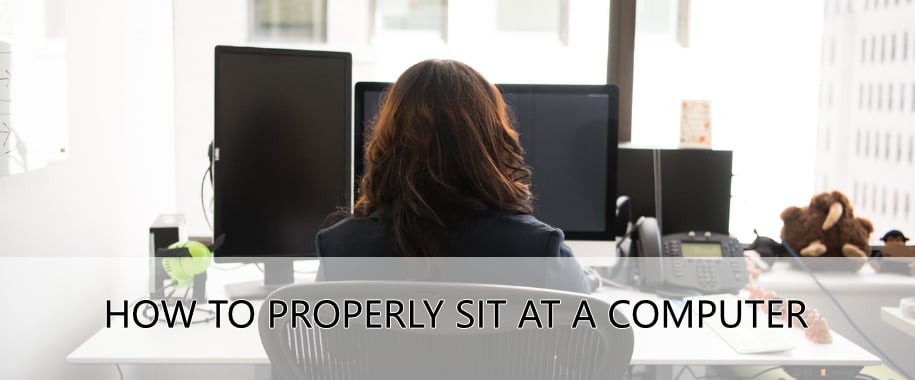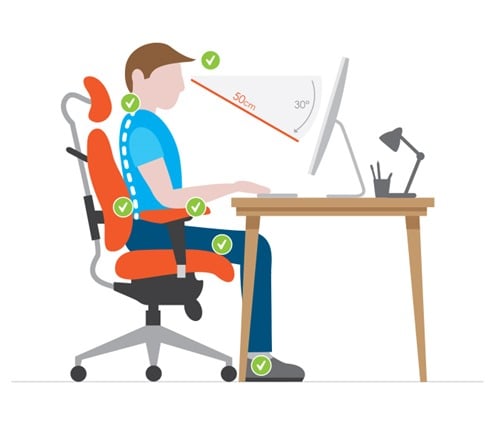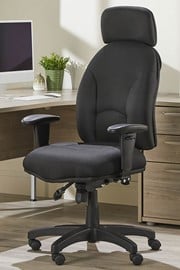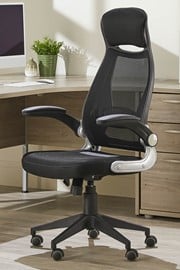
Back pain is an all too familiar occurrence for the modern-day office worker and it can severely hamper our performance and productivity when on the job.
Couple this with the fact that the UK works some of the longest hours in Europe (averaging 42.5 hours a week), it’s no wonder that many of us suffer from sitting induced back pain.
It’s not only back pain that can be caused from sitting poorly at an office desk either. There’s a risk to your neck, knees, hips and even contributing to poor circulation throughout the body.
Sitting for 6-8 hours every day in the office will naturally lead people to slump in their office chair unless they are mindful about how they sit - and this takes practice.
How To Sit Properly In An Office Chair
It may seem obvious on the surface, but being mindful of how you sit and sitting correctly takes practice and is harder than you think. Too often we find ourselves delving back into our bad habits that see such hunched over our office desk keyboard putting strain on our upper back and neck or slumped in our chair without adequate support on our lower back.

- Sit up straight and allow your shoulders and neck to relax into a natural position
- Ensure your feet are flat on the ground just under your knees
- Position your knees to be slightly lower than your hips (use a footstool if necessary)
- Support your back properly by sitting deep into the office chair and adjust the office back and lumbar support to suit the curve of your spine
- Keep your thighs parallel to the floor
- Avoid crossing your legs as this can lead to posture-related problems
- With the aid of your office chair’s arms, keep your forearms extended horizontally and your wrists straight
- Keep your monitor approximately an arm's length away and ensure the top of the screen is level with your eyes. Monitor arms are exceptional for ensuring your monitor aligns perfectly with your eye level, promoting optimal viewing and posture.
How to Resist Slouching In Your Office Chair
Maintaining a correct sitting posture in an office chair is surprisingly hard. Many of us fall into the trap of slouching without meaning too. If we’re not practising mindfulness while sitting, it’s very easy to find ourselves hunched over towards the end of the workday.
It’s recommended that we change position every 30 minutes but this can lead us to slump leading to poor posture.
The best solution is to stand up and take a break for a couple of minutes. Whether you take a stroll down the corridor, grab a glass of water or take that time to use the bathroom. Whatever you do, do it often so you can keep your blood flowing properly and ‘reset’ your ‘good posture’ position when you sit back down again.
While you might be self-conscious about stretching in the office, it’s highly advisable. Our bodies are not made to sit continuously for 6-8 hours a day. We need to stretch. We need to move about. Setting a timer for every 30 minutes will help you remember to stand up and move. The more you do this, the more of a habit it will become - and you’ll feel much better for it.
Moving about more regularly also helps reduce the risk of a repetitive strain injury which can occur for office workers mainly in the wrists and hands.
Invest In A Good Ergonomic Office Chair
Ensuring you have good posture is much easier when you have the right ergonomic office chair.
Ergonomic office chairs are scientifically built with posture, comfort, support and health in mind. A good chair will help with all four of these considerations and for long term office workers, an ergonomic chair is vital.
The ergonomics of a chair explained is quite a lengthy process, but here’s a summary of what makes an office chair, ergonomic.
- Seat Height - Enabling you to lower or raise the seat in accordance with your personal height. This allows you to keep your keep flat on the ground when sitting correctly
- Seat Pan Depth - Position how far forward you back you would like the seat. Again this is in accordance with your size, as each of us are different from one another
- Backrest Height - Tailor the backrest height to follow the natural curve of your spine. For taller people, the backrest will want to be positioned much higher than a shorter person
- Swivel Base - A swivel base enables you to turn to face different parts of your office desk. This helps decrease the likelihood of twisting in an unnatural position to reach for something such as a telephone
- Back Angle - This allows you to recline the backrest to help take some of the weight off your upper body
- Seat Tilt - Position your seat to a comfortable angle for your pelvis while also keeping your thighs horizontal to the ground for maximum comfort and positioning
- Arm Support - Adjust the height and width of your office chair arms to be aligned with your desk height and keyboard
- Lumbar Support - Fully adjustable lumbar support to ensure the natural ‘s’ shape of our spine is fully supported
- Headrest - Take the strain off upper back and shoulders by positioning the headrest correctly
Take a look at our Best Selling Ergonomic Office Chairs

Venus

Colton Ergonomic Mesh Office Chair

Saturn Folding Arm Mesh Chair
As seen above, there’s more to an ergonomic office chair than initially thought and with all these features combined, you can feel more comfortable and healthy while sitting at your office desk.
Is there a correct office chair? Everyone is different in size and weight therefore not one chair is suitable for everyone. There is no one-size-fits-all. But all these adjustable features help tailor your chair to your exact requirements.
Do you need advice on what ergonomic office chair to buy? Call our friendly customer team on 01234 834693 and they will help you.
Latest Blog Posts

Choosing the Best Width Desk For Your Workspace
Posted on 26/06/2025
How Deep Should a Desk Be?
Posted on 23/05/2025
What is a Noticeboard? A Comprehensive Guide
Posted on 19/03/2025
36 Office Etiquette Rules to Follow for a Better Workplace
Posted on 27/02/2025